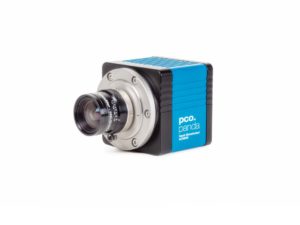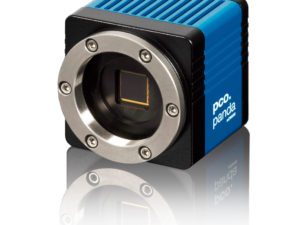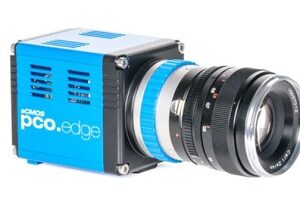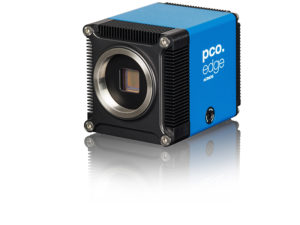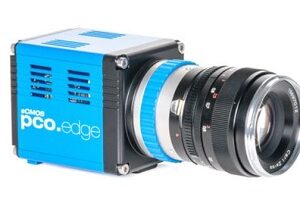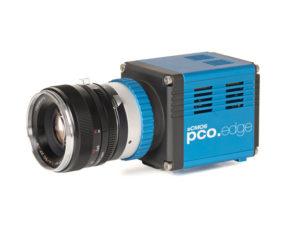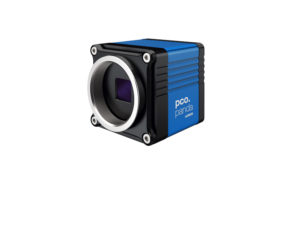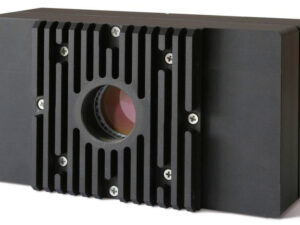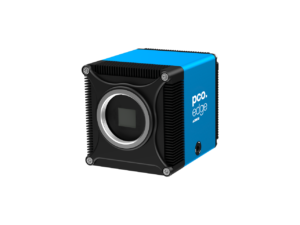Description
The pco.edge 4.2 is is equipped with an innovative scientific CMOS sensor providing crisp images and precise measurements. The pco.edge 4.2 camera system is designed for users who require highest quantum efficiency, best 16 bit dynamic range, high frame rates and long exposure times. In addition, the camera has an extremely low readout noise of 0.8 e- med; it is air cooled with the option to upgraded to a water cooling system. Camera Link HS guarantees uncompressed and secure data transfer. The latest standard of high-performance data interfaces enables the bridging of long distances via fiber optic cable. Alternatively, Camera Link full and USB 3.0 interfaces are also available. Use the pco.edge 4.2 sCMOS camera system with the latest software from PCO.
Key Features:
- thermal stabilization at 0°C / +5 °C / +7 °C
- extremely low readout noise of 0.8 e- med
- high resolution of 2048 x 2048 pixel
- dynamic range of 37 500 : 1 (USB / Camera Link HS) / 33 000 : 1 (CL)
- quantum efficiency up to 82%
- exposure times from 100 µs to 20 s
- maximum frame rate 100 fps
- rolling shutter or global reset (USB) mode
- lightsheet mode
- Camera Link HS, Camera Link full or USB 3.0 interface
- small form factor: 102 x 79 x 70 mm (USB / CL)
- optional: water cooling system
Technical Specifications:
| Unit | Setpoint | pco.edge 4.2 |
| Resolution (hor x vert) | pixel | | 2048 x 2048 |
| Pixel size (hor x vert) | µm | | 6.5 x 6.5 |
| Peak Quantum Efficiency | % | @ 590 nm typ. | up to 82 |
| Dynamic Range A/D | bit | | 16 |
| Readout Noise | e- med | USB
CL
CLHS | 0.8
0.9
0.8 |
| Frame Rate | fps | @ full frame (USB)
@ full frame (CL/CLHS) | 40
100 |
| Exposure Time Range | | @ Rolling Shutter (USB)
@ Global Reset (USB)
@ Rolling Shutter (CL) | 100 µs - 20 s
30 µs - 2 s
100 µs - 10 s |
| Region of Interest (ROI) | | | selectable |
| Optical Input | | | Nikon F-mount,
C-mount |
| Data Interface | | | CameraLink (full, 10tap)
Camera Link HS
USB 3.0 |
Quantum Efficiency Curve:

View / Download the datasheet here.
Applications Areas:
- GSDIM
- PALM
- STORM
- SPIM
- SIM
- spinning disk confocal microscopy
- FRET
- FRAP
- EOS 3D
- adaptive optics
- solar astronomy
- fluorescence spectroscopy
- bio- & chemi-luminescence
- high content screening
- ophthalmology
- flow cytometry
- biochip reading
Application Examples:
Modular Wafer Inspection with pco.edge 5.5
 Silicon carbide (SiC) is a wide bandgap semiconductor, which is especially used for high-power, high-temperature and high-frequency devices due to its high energy efficiency. Despite great improvements in the material quality of SiC substrates and epitaxial wafers within the last years, critical defects like stacking faults (SFs) and basal plane dislocations (BPDs) can still lead to bipolar degradation and finally to complete failure of the device. Read more about this here.
Silicon carbide (SiC) is a wide bandgap semiconductor, which is especially used for high-power, high-temperature and high-frequency devices due to its high energy efficiency. Despite great improvements in the material quality of SiC substrates and epitaxial wafers within the last years, critical defects like stacking faults (SFs) and basal plane dislocations (BPDs) can still lead to bipolar degradation and finally to complete failure of the device. Read more about this here.
Fluorensce Microscopy DNA Micro Arrays with pco.edge series
 Microarrays are versatile tools for high throughput screening. Nevertheless they are severely limited. Either the molecules are synthesized in-situ directly on the surface or in-vitro or in-vivo produced externally and then transferred onto the surface. In-situ synthesis shows low yield in terms of purity and restricts therefore the biomolecule probe length to ~50 bp for light-synthesized DNA (Affymetrics) or ~200 bp print-synthesis (Agilent), but allows up to millions of spots per array. Ex-array synthesis on the other hand provides high-purity molecules, but the (bio)synthesis and purification of these molecules is tedious, time consuming and expansive. Also the printing process takes time. Even if one spot can be made per second 100,000 spots will take more than a day. Therefore the idea arose why to copy microarrays. Why not make DNA, RNA and protein microarrays as high quality copies of a high quality original? It worked fine for text books and images. So why not apply it for DNA? Why not build a biomolecule copying machine? A biomolecule xeroxer? Read more about this here.
Microarrays are versatile tools for high throughput screening. Nevertheless they are severely limited. Either the molecules are synthesized in-situ directly on the surface or in-vitro or in-vivo produced externally and then transferred onto the surface. In-situ synthesis shows low yield in terms of purity and restricts therefore the biomolecule probe length to ~50 bp for light-synthesized DNA (Affymetrics) or ~200 bp print-synthesis (Agilent), but allows up to millions of spots per array. Ex-array synthesis on the other hand provides high-purity molecules, but the (bio)synthesis and purification of these molecules is tedious, time consuming and expansive. Also the printing process takes time. Even if one spot can be made per second 100,000 spots will take more than a day. Therefore the idea arose why to copy microarrays. Why not make DNA, RNA and protein microarrays as high quality copies of a high quality original? It worked fine for text books and images. So why not apply it for DNA? Why not build a biomolecule copying machine? A biomolecule xeroxer? Read more about this here.
LSFM HSPM Timelapse with pco.edge series
 Oblique plane microscopy (OPM) is a form of light sheet microscopy that uses a single high numerical aperture microscope objective for both fluorescence excitation and collection. Read more about this here.
Oblique plane microscopy (OPM) is a form of light sheet microscopy that uses a single high numerical aperture microscope objective for both fluorescence excitation and collection. Read more about this here.
Particle Imaging Velocimetry Tour de France with pco.edge 5.5
 Particle Image Velocimetry not only allows visualizing the airflow around the bike and rider, but also accurately measures the flow in detail. Development engineers use these results to optimize the performance of bike and clothing and help André Greipel in this way to reach new sportive achievements. Read more about this here.
Particle Image Velocimetry not only allows visualizing the airflow around the bike and rider, but also accurately measures the flow in detail. Development engineers use these results to optimize the performance of bike and clothing and help André Greipel in this way to reach new sportive achievements. Read more about this here.
EOS 3D Printing with pco.edge 5.5
 Additive manufacturing is currently making a giant leap towards mass production. Technological processes have matured and industrial 3D printing has proven to be an efficient manufacturing process. EOS is launching an innovative quality monitoring solution for optical tomography. The heart of the system is the pco.edge sCMOS camera. Read more about this here.
Additive manufacturing is currently making a giant leap towards mass production. Technological processes have matured and industrial 3D printing has proven to be an efficient manufacturing process. EOS is launching an innovative quality monitoring solution for optical tomography. The heart of the system is the pco.edge sCMOS camera. Read more about this here.
Propeller Induced Properties with pco.edge 5.5/pco.4000
 Multiple optical measurement techniques have been applied for the investigation of a propeller-wing wind tunnel model. The (half) wind tunnel model is equipped with a nine bladed propeller and its wing has active Coanda blowing over the whole span of the wing. Read more about this here.
Multiple optical measurement techniques have been applied for the investigation of a propeller-wing wind tunnel model. The (half) wind tunnel model is equipped with a nine bladed propeller and its wing has active Coanda blowing over the whole span of the wing. Read more about this here.




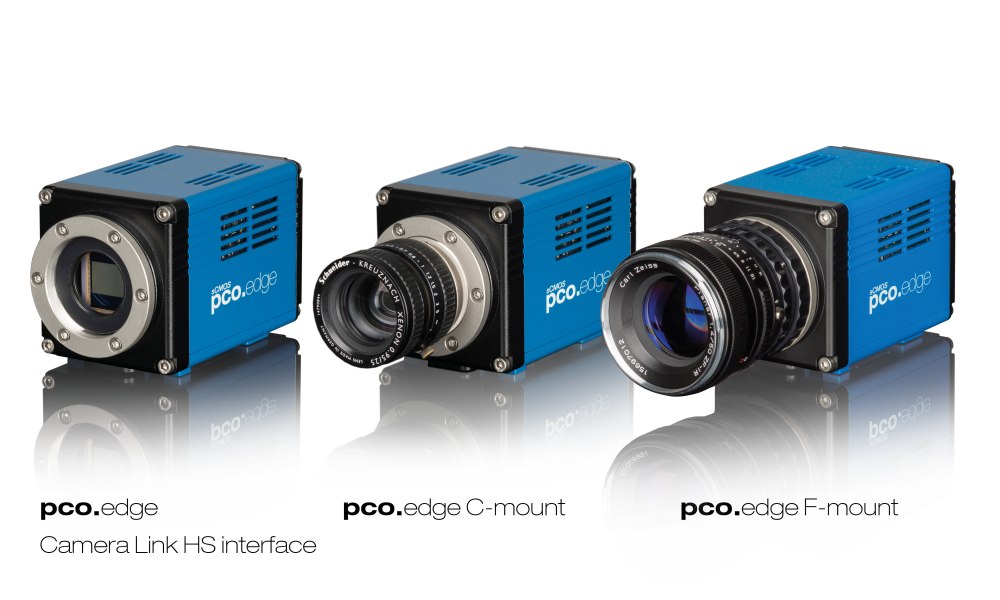
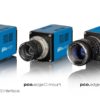
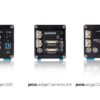
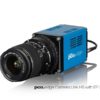
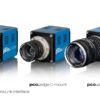
 Silicon carbide (SiC) is a wide bandgap semiconductor, which is especially used for high-power, high-temperature and high-frequency devices due to its high energy efficiency. Despite great improvements in the material quality of SiC substrates and epitaxial wafers within the last years, critical defects like stacking faults (SFs) and basal plane dislocations (BPDs) can still lead to bipolar degradation and finally to complete failure of the device.
Silicon carbide (SiC) is a wide bandgap semiconductor, which is especially used for high-power, high-temperature and high-frequency devices due to its high energy efficiency. Despite great improvements in the material quality of SiC substrates and epitaxial wafers within the last years, critical defects like stacking faults (SFs) and basal plane dislocations (BPDs) can still lead to bipolar degradation and finally to complete failure of the device.  Microarrays are versatile tools for high throughput screening. Nevertheless they are severely limited. Either the molecules are synthesized in-situ directly on the surface or in-vitro or in-vivo produced externally and then transferred onto the surface. In-situ synthesis shows low yield in terms of purity and restricts therefore the biomolecule probe length to ~50 bp for light-synthesized DNA (Affymetrics) or ~200 bp print-synthesis (Agilent), but allows up to millions of spots per array. Ex-array synthesis on the other hand provides high-purity molecules, but the (bio)synthesis and purification of these molecules is tedious, time consuming and expansive. Also the printing process takes time. Even if one spot can be made per second 100,000 spots will take more than a day. Therefore the idea arose why to copy microarrays. Why not make DNA, RNA and protein microarrays as high quality copies of a high quality original? It worked fine for text books and images. So why not apply it for DNA? Why not build a biomolecule copying machine? A biomolecule xeroxer?
Microarrays are versatile tools for high throughput screening. Nevertheless they are severely limited. Either the molecules are synthesized in-situ directly on the surface or in-vitro or in-vivo produced externally and then transferred onto the surface. In-situ synthesis shows low yield in terms of purity and restricts therefore the biomolecule probe length to ~50 bp for light-synthesized DNA (Affymetrics) or ~200 bp print-synthesis (Agilent), but allows up to millions of spots per array. Ex-array synthesis on the other hand provides high-purity molecules, but the (bio)synthesis and purification of these molecules is tedious, time consuming and expansive. Also the printing process takes time. Even if one spot can be made per second 100,000 spots will take more than a day. Therefore the idea arose why to copy microarrays. Why not make DNA, RNA and protein microarrays as high quality copies of a high quality original? It worked fine for text books and images. So why not apply it for DNA? Why not build a biomolecule copying machine? A biomolecule xeroxer?  Oblique plane microscopy (OPM) is a form of light sheet microscopy that uses a single high numerical aperture microscope objective for both fluorescence excitation and collection.
Oblique plane microscopy (OPM) is a form of light sheet microscopy that uses a single high numerical aperture microscope objective for both fluorescence excitation and collection.  Particle Image Velocimetry not only allows visualizing the airflow around the bike and rider, but also accurately measures the flow in detail. Development engineers use these results to optimize the performance of bike and clothing and help André Greipel in this way to reach new sportive achievements.
Particle Image Velocimetry not only allows visualizing the airflow around the bike and rider, but also accurately measures the flow in detail. Development engineers use these results to optimize the performance of bike and clothing and help André Greipel in this way to reach new sportive achievements.  Additive manufacturing is currently making a giant leap towards mass production. Technological processes have matured and industrial 3D printing has proven to be an efficient manufacturing process. EOS is launching an innovative quality monitoring solution for optical tomography. The heart of the system is the pco.edge sCMOS camera.
Additive manufacturing is currently making a giant leap towards mass production. Technological processes have matured and industrial 3D printing has proven to be an efficient manufacturing process. EOS is launching an innovative quality monitoring solution for optical tomography. The heart of the system is the pco.edge sCMOS camera.  Multiple optical measurement techniques have been applied for the investigation of a propeller-wing wind tunnel model. The (half) wind tunnel model is equipped with a nine bladed propeller and its wing has active Coanda blowing over the whole span of the wing.
Multiple optical measurement techniques have been applied for the investigation of a propeller-wing wind tunnel model. The (half) wind tunnel model is equipped with a nine bladed propeller and its wing has active Coanda blowing over the whole span of the wing. 